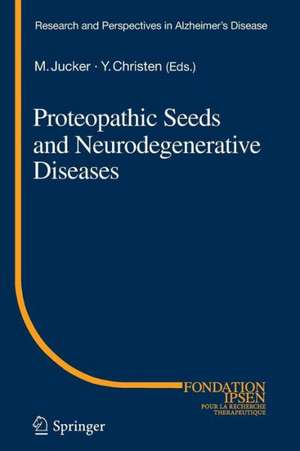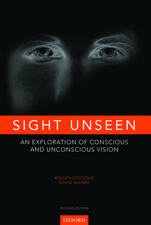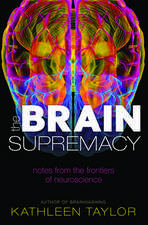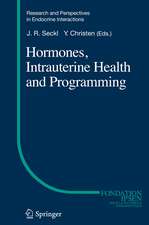Proteopathic Seeds and Neurodegenerative Diseases: Research and Perspectives in Alzheimer's Disease
Editat de Mathias Jucker, Yves Christenen Limba Engleză Paperback – 8 feb 2015
| Toate formatele și edițiile | Preț | Express |
|---|---|---|
| Paperback (1) | 938.51 lei 6-8 săpt. | |
| Springer Berlin, Heidelberg – 8 feb 2015 | 938.51 lei 6-8 săpt. | |
| Hardback (1) | 946.55 lei 6-8 săpt. | |
| Springer Berlin, Heidelberg – 12 apr 2013 | 946.55 lei 6-8 săpt. |
Din seria Research and Perspectives in Alzheimer's Disease
- 18%
 Preț: 943.57 lei
Preț: 943.57 lei - 18%
 Preț: 1833.48 lei
Preț: 1833.48 lei - 18%
 Preț: 943.73 lei
Preț: 943.73 lei - 5%
 Preț: 1094.80 lei
Preț: 1094.80 lei - 18%
 Preț: 957.13 lei
Preț: 957.13 lei - 24%
 Preț: 1035.49 lei
Preț: 1035.49 lei - 18%
 Preț: 941.82 lei
Preț: 941.82 lei - 18%
 Preț: 1216.48 lei
Preț: 1216.48 lei - 18%
 Preț: 1211.74 lei
Preț: 1211.74 lei - 18%
 Preț: 937.58 lei
Preț: 937.58 lei - 5%
 Preț: 707.33 lei
Preț: 707.33 lei - 5%
 Preț: 716.09 lei
Preț: 716.09 lei - 5%
 Preț: 711.32 lei
Preț: 711.32 lei - 15%
 Preț: 636.30 lei
Preț: 636.30 lei - 5%
 Preț: 707.86 lei
Preț: 707.86 lei - 5%
 Preț: 712.60 lei
Preț: 712.60 lei - 5%
 Preț: 711.52 lei
Preț: 711.52 lei - 5%
 Preț: 712.25 lei
Preț: 712.25 lei - 15%
 Preț: 631.86 lei
Preț: 631.86 lei - 5%
 Preț: 707.50 lei
Preț: 707.50 lei - 15%
 Preț: 639.08 lei
Preț: 639.08 lei - 5%
 Preț: 365.99 lei
Preț: 365.99 lei - 15%
 Preț: 636.30 lei
Preț: 636.30 lei - 5%
 Preț: 367.84 lei
Preț: 367.84 lei - 15%
 Preț: 635.80 lei
Preț: 635.80 lei - 18%
 Preț: 1211.90 lei
Preț: 1211.90 lei
Preț: 938.51 lei
Preț vechi: 1144.53 lei
-18% Nou
Puncte Express: 1408
Preț estimativ în valută:
179.60€ • 195.02$ • 150.87£
179.60€ • 195.02$ • 150.87£
Carte tipărită la comandă
Livrare economică 22 aprilie-06 mai
Preluare comenzi: 021 569.72.76
Specificații
ISBN-13: 9783642446962
ISBN-10: 3642446965
Pagini: 168
Ilustrații: XII, 156 p.
Dimensiuni: 155 x 235 x 9 mm
Greutate: 0.25 kg
Ediția:2013
Editura: Springer Berlin, Heidelberg
Colecția Springer
Seria Research and Perspectives in Alzheimer's Disease
Locul publicării:Berlin, Heidelberg, Germany
ISBN-10: 3642446965
Pagini: 168
Ilustrații: XII, 156 p.
Dimensiuni: 155 x 235 x 9 mm
Greutate: 0.25 kg
Ediția:2013
Editura: Springer Berlin, Heidelberg
Colecția Springer
Seria Research and Perspectives in Alzheimer's Disease
Locul publicării:Berlin, Heidelberg, Germany
Public țintă
ResearchCuprins
Preface.- Widening Spectrum of Prions Causing Neurodegenerative Diseases (Stanley B. Prusiner).- b-Amyloid Fibril Structures, In Vitro and In Vivo (Robert Tycko).- Structure-Activity Relationship of Amyloids (Jason Greenwald and Roland Riek).- Seeding and Cross-seeding in Amyloid Diseases (Per Westermark and Gunilla T. Westermark).- The Prion-like Aspect of Alzheimer Pathology (Sarah K. Fritschi, Bahareh Eftekharzadeh, Giusi Manfredi, Tsuyoshi Hamaguchi, Götz Heilbronner, Amudha Nagarathinam, Franziska Langer, Yvonne S. Eisele, Lary Walker, Mathias Jucker).- Amyloid-β Transmissibility (Duran-Aniotz C, Morales R, Moreno-Gonzalez I, Soto C).- Prion-like Properties of Assembled Tau Protein (Florence Clavaguera, Markus Tolnay, and Michel Goedert).- Accumulating Evidence Suggests that Parkinson´s Disease is a Prion-like Disorder.- Nolwen L. Rey, Elodie Angot, Christopher Dunning, Jennifer A. Steiner, Patrik Brundin).- Propagation and Replication of Misfolded SOD1: Implications for Amyotrophic Lateral Sclerosis (Anne Bertolotti).- Development of Drugs that Target Proteopathic Seeds Will Require Measurement of Drug Mechanism in Human Brain (Peter T. Lansbury).- The Role of Functional Prions in the Persistence of Memory Storage (Eric R. Kandel, Irina Derkatch, Elias Pavlopoulos).- Subject Index.
Textul de pe ultima copertă
The misfolding and aggregation of specific proteins is an early and obligatory event in many of the age-related neurodegenerative diseases of humans, and appears to occur many years before the onset of clinical symptoms. The initial cause of this pathogenic cascade and the means whereby disease spreads through the nervous system, remain uncertain. A recent surge of research, first instigated by pathologic similarities between prion disease and Alzheimer’s disease, has increasingly implicated corruptive protein templating, or seeding, as a prime factor in the neurodegenerative process. The prion-like corruption of proteins also characterizes such clinically and etiologically diverse neurological disorders as Parkinson’s disease, Huntington’s disease, amyotrophic lateral sclerosis, and frontotemporal lobar degeneration. Understanding the misfolding, aggregation, trafficking and pathogenicity of affected proteins thus could reveal universal principles and common therapeutic targets forsome of the most devastating and intractable human brain disorders.
Caracteristici
With contributions from nobel laureats Eric Kandel and Stanley Prusiner Latest research on prion diseases Presents developing therapies ? Includes supplementary material: sn.pub/extras














